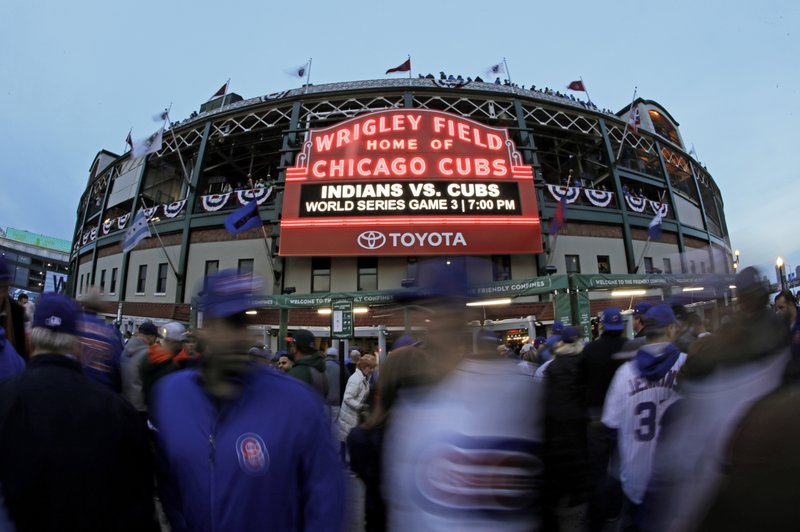CHICAGO -- Dressed in dark, furry bear suits from head to toe, Lisa Burton and Brian Robinson stood on Waveland Avenue, waiting to walk up to the rooftop of Beyond the Ivy and watch the first World Series game at Wrigley Field in 71 years.
Burton, 39, and Robinson, 43, said they paid a total of $7,500 for a pair of tickets to take in all three games against Cleveland from across the street this weekend. The engaged couple made their way to Chicago's North Side from Birmingham, Ala.
All that money, and they're not even sitting inside the ballpark.
"It felt like a bargain," Robinson said. "I've been a Cubs fan since I was about 6 years old. I was born and raised in Meridian, Miss. You had two choices: You could watch the Braves or the Cubs. But Harry Caray was so much more fun to watch, even when the Cubs stunk, which was most of the time. He was the reason why I became a Cubs fan."
When the World Series last came to Wrigley Field, a Game 7 loss to Detroit on Oct. 10, 1945, the major leagues were all-white, the championship was played in the daytime, TV had not yet come to the Fall Classic and soldiers were coming home from World War II.
Now the Cubbies were home in the Friendly Confines, three victories from their first title since 1908. And on an uncommonly warm 63-degree Friday night with the wind blowing out to left and center at 14 mph, Wrigleyville was the meeting grounds for fans who long imagined a day like this, part hope, part pipe dream.
Only now it was coming true.
Back in 1945, Series box seats had a list price of $7.20. This year's tickets ranged from $85 to $565, and asking prices on StubHub a few hours before game time ranged from $1,019 to $9,439.
Debbie Manfredi, of suburban Algonquin, stood on Kenmore Avenue trying to snag balls off the bat of right-handed hitters during batting practice. The 49-year-old, wearing a Cubs jersey signed by Ron Santo, has had season tickets in the lower deck behind third base for five years -- after 11 years spent on the waiting list. Her late father, Richard, grew up in Wrigleyville and rode his bicycle to games, then had season tickets in the 1970s. Debbie was taking her 15-year-old daughter, Taylor, to the game.
"I started believing last year, and this year you just felt it from the beginning. You just knew," she said.
Not far away, fans were being fed hot dogs outside the two-story building that houses Engine Co. 78 and Ambulance Co. 6. Many held white flags with a blue "W," a variation of the one that flies from the scoreboard after home victories.
With a capacity of about 41,000, seats painted in a dark Benjamin Moore Green SC-62 and poles holding up its roof (and creating obstructed views), Wrigley is the focal point of its gentrified neighborhood, about 5½ miles from The Loop downtown. Even the handles of the doors of Starbucks across from the right-field corner are made of baseball bats.
Hours before first pitch, the line to get into Murphy's Bleachers snaked down Sheffield Avenue toward Addison Street, which runs along the first-base side of the ballpark. Statues of Ron Santo and Billy Williams had new jerseys and red roses, and Caray's had a yellow apple in one hand.
"You're getting to play in a museum -- for work," said 39-year-old Cubs catcher David Ross, who is retiring after the Series. "Last year I walked to the park a lot and that was my favorite thing about last year, was just walking to the park and feeling the energy of the fans."
Known as Weeghman Park when it opened for Chicago's Federal League club in 1914, Wrigley has been the Cubs' home since 1916 and it retains most of its traditional look, even in the midst of a $375 million renovation that created a spacious new Cubs underground clubhouse this season and will lead to the relocation of the bullpens from the foul lines to underneath the bleachers next year.
The second-oldest ballpark in the major leagues behind Boston's Fenway Park (1912), Wrigley did not even have lights for night games until 1988. A pair of video boards were erected last year, 42-by-95 feet in left and 29-by-71 feet in right, flanking the tradition hand-operated green scoreboard with white lettering and a circular clock atop the center-field bleachers, a focal point like a cherry on a cake.
Cramped dugouts are more like World War I trenches than the roomy, comfortable benches in more modern venues. The famous ivy along with red brick outfield walls, first installed in 1937, is green during sultry summers and thick enough to gobble up balls ahead of searching outfielders in baseball's version of Little Shop of Horrors, but in the cool of autumn it has dulled and thinned, starting to turn brown in patches.
"It's how baseball is supposed to be," said Indians Manager Terry Francona, who played for the 1986 Cubs. "When I was here, they didn't have the new clubhouse, so it was fun being at the ballpark until it was time to shower or go to the bathroom or something."
Wrigley hosted Series games in 1929, '32, '35, '38 and '45, with the Cubs losing their first five and 11 of 13 overall entering this year.
"This is so enveloping. The fact that the bleachers come all the way around," Cubs Manager Joe Maddon said. "I drive down Clark every day from downtown, and as you get closer, you see all the venues that support all this, and also the people milling around. Any place I've been, I haven't seen that with any ballpark to that level. So its enormity in its entirety, it's just different."
Sports on 10/29/2016
